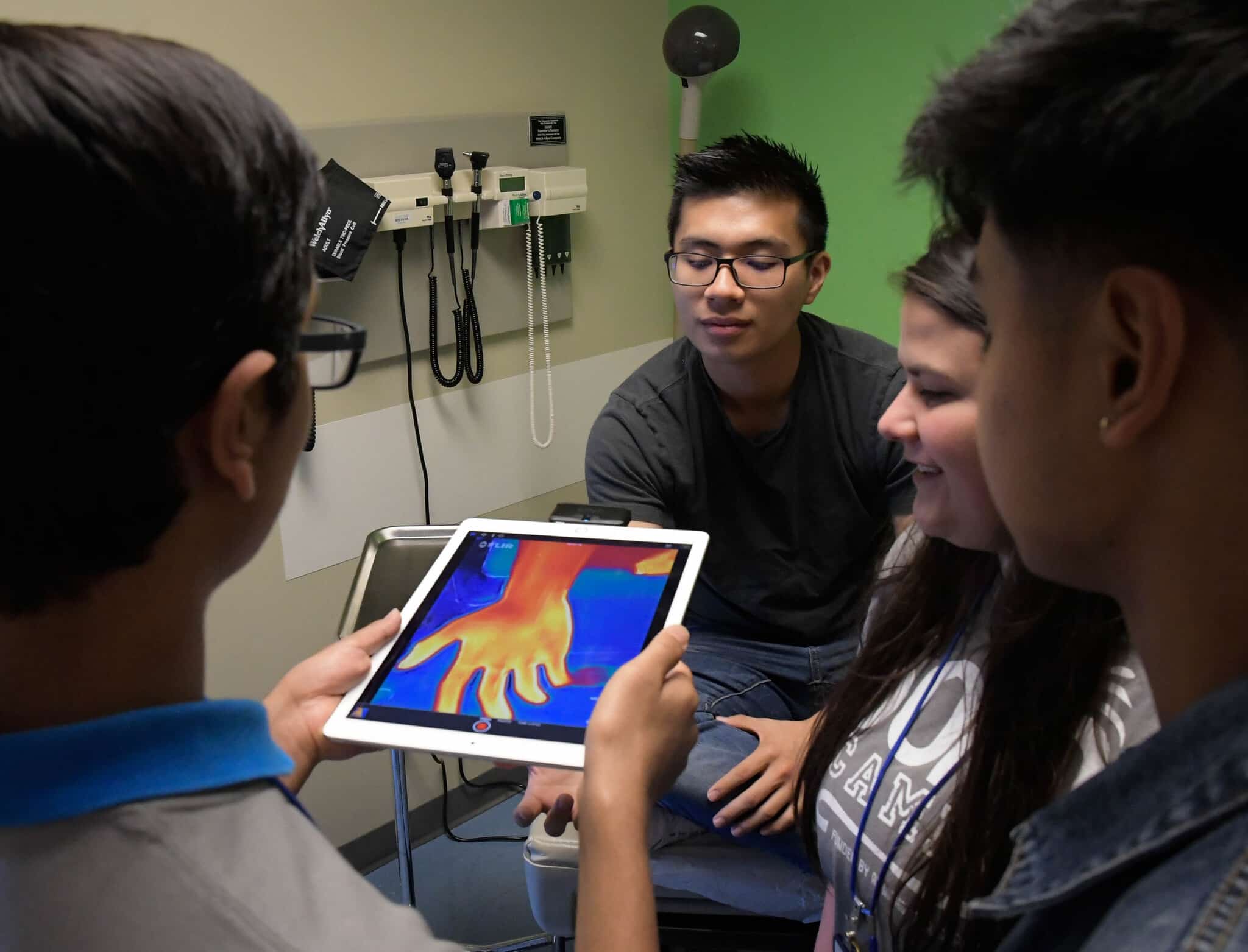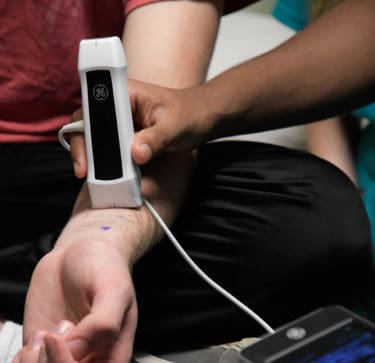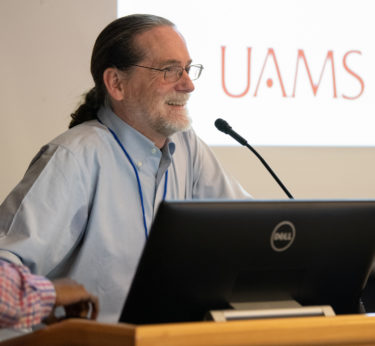SONOcamp Aims to Inspire STEM Possibilities for High School Students
| “So if I told you this is where the diaphragm sits, where do you think the right superior, middle, and inferior lobes are on him?”
Kevin D. Phelan, Ph.D., co-director of the Division of Clinical Anatomy in the UAMS College of Medicine, drew an arc with his finger just along the bottom of the rib cage on the “patient” — actually a UAMS medical student — while a group of high school students from the Little Rock School District followed the gesture with their eyes.
“Think about when we saw the lungs in the lab this morning.”
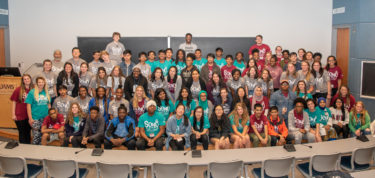
The high school students were all from the Little Rock School District and spent a week in hands-on labs at UAMS.
The students hesitated.
“It’s weird, right, taking what you saw and now thinking about where that sits in the body? Our medical students have to learn that too. Talk amongst yourselves and use these stickers to label the lobes. Do the left side too.”
A student took the stickers, assumed a leadership role, and the discussion started. By the end, they correctly labeled all of the lobes except the — admittedly tricky — right inferior, which Phelan adjusted by a couple of centimeters. Next, they used a spirometer to measure the patient’s lung flow and volume, while watching the results appear in real time on an iPad.
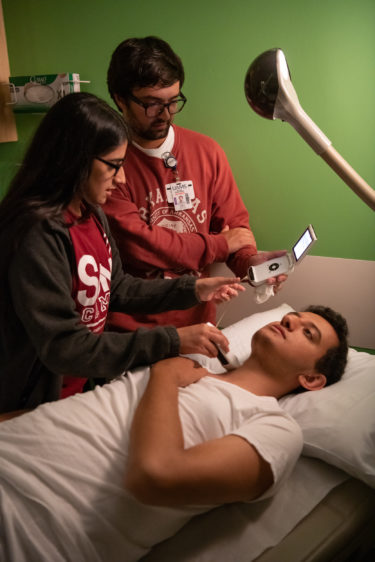
Students use a hand-held ultrasound to explore a volunteer’s neck to learn about cardiovascular health.
SONOcamp Uses Hands-On Tech
Welcome to SONOcamp, held June 10-14 at UAMS with 60 Little Rock high school students.
Similar scenes repeated throughout week with the heart, kidneys, gastrointestinal tract, vasculature, and more. The students used hand-held ultrasounds, augmented reality, infrared cameras, and a 3D anatomy simulation table in same gross anatomy lab and patient simulation center used to train UAMS medical students. They learned about applying tourniquets in the field and saw a simulation of fetal sonography.
They interacted with faculty and students from the UAMS College of Medicine, College of Health Professions, College of Nursing and Graduate School, and undergraduate students who are conducting biomedical research through the Arkansas INBRE program.
The camp focused on hands-on, tech-heavy lab experiences. At the end of the week, they tested their knowledge and skills at the SONOlympics.
Twelve medical students helped lead the small-group exercises. Ryan Coleman, who is entering his second year of medical school, said he was amazed by the advanced labs and tech the students were able to experience because of the camp.
“I never used an ultrasound for anything before I came to med school,” Coleman said. “I had never done any human dissection before I came to med school. This is a very real experience for them. A lot of the things that they’ve learned in this camp, I literally learned this year or — in some cases — I learned this week, right along with them.”
Despite the complexity of some of the concepts, Coleman said, the camp’s goal to use hands-on tech to aid in student interest appeared to be working.
“It’s been really interesting to see how much they’ve actually retained,” Coleman said. “We did our trivia session, the SONOlympics, on the last day, and they got a lot of it right — like a lot — and that was really impressive.”
Grant Enables STEM Educational Outreach
As great as SONOcamp is, it’s only one small part of a larger project called ArkanSONO.
In 2018, Phelan received a $1.27 million, five-year science education research grant called a Science Education Partnership Award (SEPA) from the National Institute of General Medical Sciences, with is part of the National Institutes of Health.
Phelan is researching whether using handheld and interactive technology to teach students about health will inspire more students to pursue careers in STEM: science, technology, engineering and math.
“More and more educational research is showing that the sooner young people are exposed to STEM careers, the greater the likelihood they’re carry that interest into adulthood,” Phelan said. “If we’re going to support the STEM careers of the future, we have to inspire younger students by showing them their real-life potential before they disengage and start to believe it’s not a path that’s interesting or open to them.”
The program also aims to teach students about cardiovascular health, which is a leading cause of death in Arkansas. The students learned how the heart and blood vessels work and the importance of exercise, eating a healthy diet and refraining from smoking.
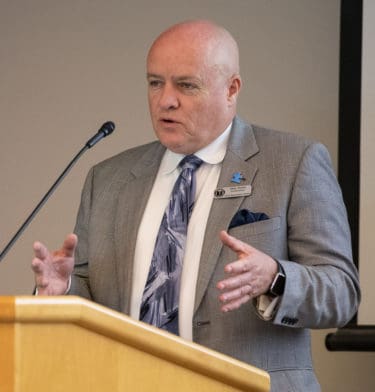
Little Rock School District Superintendent Michael Poore, Ph.D., tells the students on the first day of camp to value the experience.
The partnership with the Little Rock School District began in January with UAMS faculty visiting ninth-grade physical science classes. They used real medical-grade handheld ultrasound devices to teach basics about the physics of sound, how ultrasounds work and how they are used in various STEM fields, including medicine, biomedical research and industry.
SONOcamp was the next step in the effort to deepen student engagement. Next year, some of the students from this year’s camp will be asked to come back to assist in teaching the next group.
School Superintendent Michael Poore, Ph.D., spoke at the opening day of camp and emphasized to the students to importance of the opportunity.

The students also learned about the digestive track, both in the anatomy lab and by using ultrasounds.
“I’m very excited for you,” Poore said. “I’m excited for our district. I’m excited for our community that this opportunity has been made available. This is a unique thing. You can be proud of yourselves as the first class that ever accomplished this, and I expect you’ll hear about it years down the line. I hope you leave here fired up and excited about what possibilities your futures hold.”
The process will repeat over five years, and Phelan will track which experiences are the most successful at sparking the inspiration for careers in STEM.
As for the first group of SONOcamp participants, Phelan was impressed.
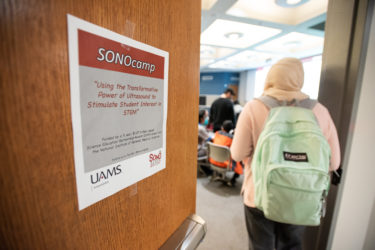 “We have a great, diverse group of students here, and all the medical students and all the faculty, we have just been amazed at their enthusiasm, their engagement and how quickly they’re learning everything, and just how excited they are to be here.”
“We have a great, diverse group of students here, and all the medical students and all the faculty, we have just been amazed at their enthusiasm, their engagement and how quickly they’re learning everything, and just how excited they are to be here.”
Phelan is joined in administering the grant, program and accompanying research by Gregory Snead, M.D., chief of the Division of Emergency Medicine Ultrasound in the UAMS College of Medicine Department of Emergency Medicine; Billy R. Thomas, M.D., a professor in the Pediatric Neonatology Department; Noor Akhter, Ph.D., and Mohsin M. Syed, Ph.D., both assistant professors in the UAMS College of Medicine Department of Neurobiology and Developmental Sciences; and Karen Yanowitz, Ph.D., professor in the Arkansas State University Department of Psychology and Counseling.
For more information about ArkanSONO and for ideas for using ultrasounds to teach science, find ArkanSONO on the UAMS College of Medicine Department of Neurobiology website — or follow @ArkanSONO on Twitter.
